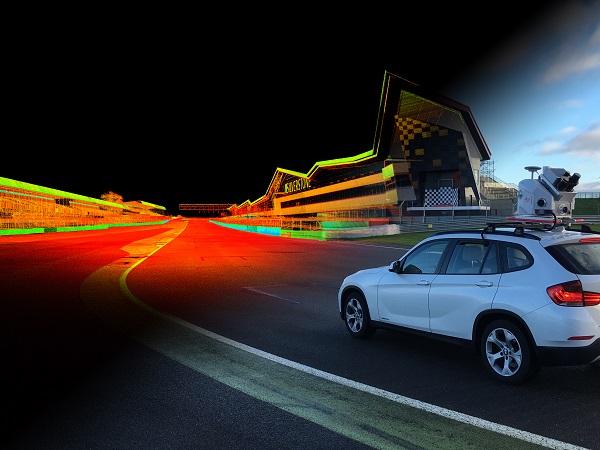This could be more than you need or have to know concerning the complexity of a mobile mapping system (MMS), but for those interested, here's an explanation the average Joe can understand. If you have a Mobile Mapping System arrive on your own job site to execute a laser scan, the machine looks like bit more than an elegant little bit of PVC strapped to the very best of a 4WD SUV. You shouldn't be fooled by its simple appearance. Inside is a modern miracle... a fashioning together of independent and amazingly complex systems that, when brought together, produce what could have seemed impossible not so way back when. This little white box of wonder, when thrilled, begins communicating with as much satellites in space as it could find. Positions are established. Movement and headings are monitored at breathtaking speed with every reading time stamped in order that every few seconds, once the computer catches its breath, the independent bits of data are perfectly spliced back together along with complex corrections to reveal a stylish reproduction of the top that was just driven past. It really is a classic thing of beauty.
Tech-savvy MMS providers use this amalgamation of technologies to provide its clients with mobile laser scanning services that produce an X, Y, Z point cloud in State Plane or similar coordinate systems. Here is a description of the various technologies used and how they tie together to generate a precise 3-D description of the areas surveyed:
How To Determine Position - GPS
Mobile Mapping Systems (MMS) utilize the Global Positioning System (GPS) to determine where we have been at a given time. The accuracy of the raw GPS data isn't adequate for the purposes so we use one of three technologies to improve the raw position information. If Click to find out more have a known control point near the job, we can create a GPS base station over that point and use measurements of GPS position from the satellites to determine the difference between the measured and actual position of that point every second. This error or "differential" is then transmitted by radio link to the Mobile Scanner and the GPS data collected by the Scanner each second is corrected. This technique is called REAL-TIME Kinematic or RTK. If no control point is available, we are able to establish one and, using industry standard tools, determine its exact location at a later time. Using RTK, we can establish our position to within �1 inch in Easting and Northing and �2 inches in elevation.
The second method we use to find out our position is comparable to RTK but is termed Virtual Reference Station or VRS. In this technique, we subscribe to a service that has a amount of base stations (the VRS Network) create in a given area. We use wireless data links to have the GPS corrections out of this Network and the data from the GPS on the Mobile Scanner is corrected as in the RTK method. The accuracy of this system is comparable to RTK.
The 3rd method we use to determine position uses OmniStar�, an exclusive satellite based correction service. It offers corrections in a manner much like VRS except that people use a satellite receiver to receive the data instead of a wireless link. The accuracy of OmniStar� is slightly significantly less than RTK or VRS at � 4 inches. We can mix and match these technologies as necessary - for example we can use RTK to accomplish the scan but define the control point using the OmniStar� system to eliminate the necessity for determining the control point position later.
How To Measure Changes in Direction - Inertial Measurement Unit
Using our GPS technology, we measure our position accurately about once per second. However, we have been constantly changing direction. At 5 miles per hour, we travel about 7 feet per second. Throughout that second, we may change our direction of travel (heading) by many degrees. The inertial measurement unit (IMU) measures changes in scanner heading 100 times per second. The accuracy of the IMU is � 0.1 degrees (~ 0.17 feet at a distance of 100 ft away). The position of the Mobile Scanner is automatically reset when it gets a new GPS position "fix" each second so any small error from the IMU isn't allowed to accumulate.
How To Collect Data of the Topography - The Laser Module
Using GPS technology and an IMU, we are able to keep track of the precise position of the Mobile Scanner at each point in time. The GPS and IMU are both mounted in the scanner housing. Outside the housing, we have a rotating laser module. This scanner includes a distance measuring laser mounted at the right angle to the direction of travel of the automobile or vessel. The laser measures 36,000 points a second, rotates around 10 RPM and contains a range of around 450 feet. The accuracy of the distance measurement is ~� 2 inches. The length between points is controlled by the laser RPM and the speed of the vehicle. We typically generate a spot cloud with points ~0.5 to 2 ft apart. The info can be thinned to lessen the size of the data sets if desired. If better data coverage is necessary, the settings in the control software can be changed. The Mobile Scanner can scan anything it really is driven past above, below or to either side of the scanner.

HOW EXACTLY TO Correct for Uneven Ground - Pitch and Roll Sensors
The Mobile Scanner is mounted to a car or vessel. In an ideal world, the ground or body of water will be perfectly horizontal. Since this is obviously false, we correct the info by measuring the pitch (uphill or downhill angle) and roll (left or right angle) of the scanner using pitch and roll sensors. These instruments measure pitch and roll 100 times per second to an accuracy of � 0.01 degrees (~ 0.02 feet at a distance of 100 ft) Because these instruments gauge the attitude of the Mobile Scanner so frequently, we are able to travel over rough terrain or in rough seas at reasonable speeds without seriously impacting the accuracy of the data.
Summary
Mobile LiDAR or Mobile Scanning as it is sometimes called can offer previously unheard of efficiency and accuracy in many survey applications. Whether you need to measure the volume of your stockpiles, do detailed mine planning, measure beach erosion, determine vegetation encroachment on utility right of ways or solve an array of survey or engineering problems, Mobile LiDar might provide the perfect solution is to your problems.
